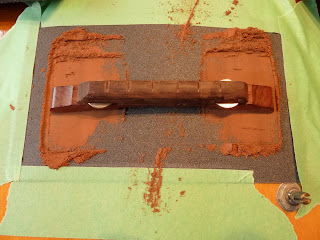This is a 1946 Gibson ES-150. The very first Electric Guitar solo was made on one of these just eight years earlier. Enough said.
This incredible guitar was previously owned by someone who obviously loved playing it so much that they forgot to clean it! Almost 70 years of buildup is covering it like a blanket, and it's new owner wanted the veil lifted. This guitar is completely original except for the tuners, which were at one point replaced with a good set of Grovers. It should come as no surprise that the cleanest part of this guitar was the back of the neck.
Those aren't gold tuners! They are chrome covered in what looks to be mostly nicotine. The footprint of the original Gibson Deluxe Kluson tuners can be seen underneath these Grovers. The fingerboard is also sporting some very thick "fretfingerfungus" that will require lots of elbow grease to remove. The frets are very well worn but have stood the test of time. They should really be replaced, but a fret dress and thorough fingerboard cleaning should bring it back to life for a good amount of time before the major work is needed.
Although caked with years of play, this guitar is still in very serviceable shape. The action is quite low and the neck is perfectly straight, and an internal inspection revealed all bracing to be intact and holding strong.
The electronics were in great shape, and required little more than dusting. The pots were only a little scratchy which was easily remedied.
Much better.
I went through five of these rags, polishing in small circles like I used to polish boots. The true colour was finally revealed! The rosewood bridge received the same lemon oil treatment as the fretboard and the tailpiece, knobs and hardware were also removed and thoroughly cleaned.
This now shiny headstock will be fitted with period correct vintage Gibson tuners.
Project complete. What an absolute treasure this instrument is! I had arranged to drop it off that afternoon to it's anxiously awaiting owner ~ but I was late. I must admit, it was very hard to put down!
It's very humbling to be trusted with such a beauty.



















































